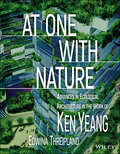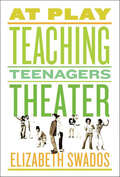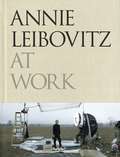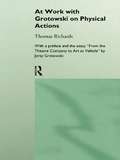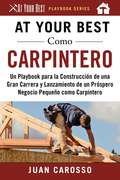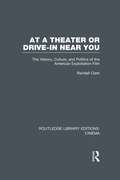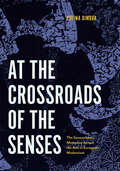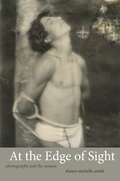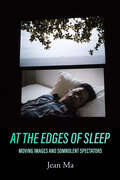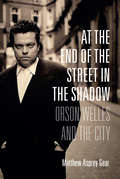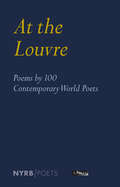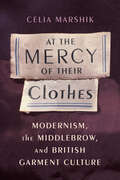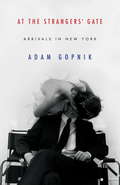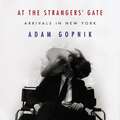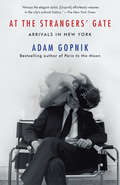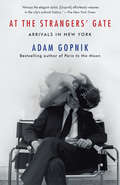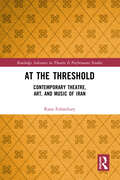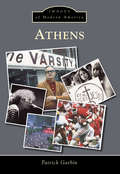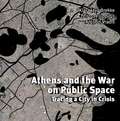- Table View
- List View
At One with Nature: Advances in Ecological Architecture in the Work of Ken Yeang
by Ken Yeang Edwina Threipland"At One with Nature is an inspiring collection of the latest work of Ken Yeang that further advances sustainable architecture and design. This collection features recent projects as he explores how we can achieve harmony between the natural and our built environments to create a better planet by design. Each project features and highlights not only the systems and devices adopted, but also outlines the intentions and ecological considerations demonstrating best practices for how we can proceed moving forward. The book role models our living Earth and shows how we can behave as stewards of our planet."--Cassia Patel, Oceanic Global Foundation At One with Nature showcases Ken Yeang's latest ideas, built projects designs, research work and advances in the field of designing with nature, a topic that Yeang has pioneered and developed over many decades since receiving his doctorate in ecological design and planning from Cambridge University. His ideas and work are even more pertinent today with the current state of devastation of Earth's natural systems and a biogeochemical cycle that has been extensively and severely impacted by human society. The global environment today is in a state of crisis, but what can society do to address the issues? Yeang's recent projects are presented with instructive diagrams that provide a basis for action for architects, planners, designers, engineers, and anyone whose daily work impinges on the natural environment. Offered in a highly visual, annotated format, with instructive illustrations of Yeang's theoretical books on the topic, At One with Nature is an invaluable resource that students and academics interested in designing with nature will find both informative and relevant.
At Play: Teaching Teenagers Theater
by Elizabeth SwadosYoung people and improvisational theater should be a natural combination—so why do we so rarely find this combo in today's classrooms? According to Elizabeth Swados—playwright, director, composer, poet, author of children's books and of an acclaimed family memoir—improvisational theater is the perfect creative outlet for junior-high and high-school students . . . if only they can be given the tools and the guidance to make the most of this natural yet rigorous art form.Drawing on her own experience teaching inner-city children in the groundbreaking musical Runaways and in teaching the techniques of improv theater in schools around the country, as well as on her own background in experimental theater, Swados provides a step-by-step guide to bringing out the natural creativity and enthusiasm key to young people creating—and enjoying—improvisational theater. Covering the basics—from freeing the imagination to learning about how to work with an ensemble, from how to master different forms of movement and sound to how to create different kinds of characters—this is the book for teachers and students eager to learn how to express fully the creative talent that all children are born with.
At Road's End: Transportation And Land Use Choices For Communities
by Cy Ulberg Lisa Wormser Dan CarlsonAt Road's End is a timely guide to a new era of holistic transportation. It presents new models for transportation planning, describes effective strategies for resolving community disputes, and offers inspiration by clearly demonstrating that new ways of planning and implementing transportation systems can work.
At Wit's End: Cartoonists of The New Yorker
by Alen MacWeeneyAn exclusive sneak peek inside the creative minds of more than 50 New Yorker cartoonists, celebrating legends and newcomers alike with stunning photography and engaging profiles.For a century, The New Yorker has provided readers with hundreds of thousands of cartoons that humorously (and accurately) encapsulate the cultural happenings in our world. From politics to pop culture, New Yorker cartoonists have found a way to make complex topics digestible through lines, shades, and clever, witty captions.In honor of the magazine&’s 100th birthday, this celebratory collection captures the brilliantly quirky personalities behind some of The New Yorker&’s most iconic cartoons. Filled with striking portraits by world-renowned photographer Alen MacWeeney, captivating profiles by long-time New Yorker contributor Michael Maslin, and a sampling of each artist&’s work, these pages offer an exclusive peek inside the creative brains of over fifty prominent cartoonists, both seasoned and newly minted. From legends like Roz Chast and Jack Ziegler to contemporaries like Liana Finck and Jeremy Nguyen, this landmark volume is a beautiful homage to the artists who have long brought joy, humor, and satire to our lives.
At Work
by Annie LeibovitzAutobiography of the famous photographer, with descriptions of how she shot her pictures of celebrities and other people, the equipment she used, and more.
At Work with Grotowski on Physical Actions
by Thomas Richards`I consider this book a precious report that permits one to assimilate some of those simple and basic principles which the self-taught at times come to know, yet only after years of groping and errors. The book furnishes information regarding discoveries which the actor can understand in practice, without having to start each time from zero. Thomas Richards has worked with me systematically since 1985. Today he is my essential collaborator in the research dedicated to Art as Vehicle.' - from the Preface by Jerzy Grotowski
At Your Best Como Carpintero: Un Playbook para la Construcción de una Gran Carrera y Lanzamiento de un Próspero Negocio Pequeño como Carpintero (At Your Best Playbooks)
by Juan CarossoLa única serie de guÃas paso a paso para tener éxito en los oficios especializados y lograr el Sueño Americano.At Your Best Como Carpintero es su libro de jugadas (su Playbook) para aprender si una carrera como carpintero es lo adecuado para usted, pasando de ser un aprendiz previo a ser un “journeyman” a ser un carpintero maestro y lanzar su propia pequeña empresa. Aprender:¿Cómo es una carrera de carpintero?¿Cómo convertirse en un artesano exitoso como carpintero?¿Cuánto se puede hacer como un carpintero?¿Cuáles son sus opciones de carrera una vez que se convierte en un carpintero?¿Cuánto tiempo se necesita para tener éxito en cada etapa de la carrera de un carpintero?¿Cómo y dónde encontrar trabajo como carpintero?¿Cuáles son las acciones especÃficas y concretas que se pueden tomar para convertirse en un empleado valioso?¿Qué se necesita para lanzarte por tu cuenta? ¿Qué ? como mÃnimo ? se necesita para poner en marcha y construir un pequeño negocio exitoso? At Your Best es el unico libro de jugadas paso a paso para descubrir si una carrera en los oficios es adecuada para usted, educándose y obteniendo las certificaciones adecuadas, estableciéndose como un excelente aprendiz y “journeyman” en la industria, y avanzando hacia iniciar su propia pequeña empresa. En cada paso del camino, At Your Best y www.AtYourBest.com proporciona la información, recomendaciones, recursos externos y acciones concretas necesarias para dar el siguiente paso exitoso en You, Inc. Ya sea que esté comenzando su primera carrera, cambiando de carrera o listo para avanzar. y comience su propio negocio como carpintero, fontanero, técnico de HVAC/R o otro comerciante, este es el libro que le dirá cómo hacerlo. Actualmente, hay más de 6.5 millones de empleos sin cubrir en los oficios calificados en los Estados Unidos. A pesar de ser bien pagados y seguros, estos trabajos permanecen abiertos porque no existen suficientes candidatos calificados con las habilidades, la actitud y la experiencia requeridas. Además, existen muchas oportunidades para que los comerciantes establecidos inicien su propio negocio, pero no tienen orientación. La serie At Your Best Playbooks y www.AtYourBest.com cambia eso.
At a Theater or Drive-in Near You: The History, Culture, and Politics of the American Exploitation Film (Routledge Library Editions: Cinema)
by Randall ClarkMillions of Americans have been thrilled, scared, titillated, and shocked by exploitation movies, low budget films with many scenes of sex, violence, and other potentially lurid elements. The term derives from the fact that promoters of such films exploit the contents in advertising that plays up the sexual or violent aspects of the films. This is the first comprehensive study of the American exploitation film to be published. It discusses five distinct genres: the teen movie, the sexploitation film, the martial arts movie, the blaxploitation film and the lawbreaker picture. Contained within these genres are many popular American film types, including beach movies, biker pictures, and women's prison movies. The study provides a history and sociopolitical analysis of each genre, focusing on significant films in those genres. It also discusses the economics of exploitation films and their place in the motion picture industry, the development of drive-in theaters, the significance of the teenage audience, and the effect of the videocassette. Finally, the book applies major film and cultural theories to establish an aesthetic for evaluating the exploitation film and to explore the relationship between film and audience.
At the Crossroads of the Senses: The Synaesthetic Metaphor Across the Arts in European Modernism (Perspectives on Sensory History)
by Polina DimovaInspired by Richard Wagner’s idea of the total artwork, European modernist artists began to pursue multimedia projects that mixed colors, sounds, and shapes. Polina Dimova’s At the Crossroads of the Senses traces this new sensory experience of synaesthesia—the physiological or figurative blending of senses—as a modernist phenomenon from its scientific description in the late nineteenth century to its prevalence in the early twentieth.Structured around twenty theses on synaesthesia, this book explores the integral relationship between modernist art, science, and technology, tracing not only how modernist artists perceptually internalized and absorbed technology and its effects but also how they appropriated it to achieve their own aesthetic, metaphysical, and social goals. Through case studies of prominent multimodal artists—Oscar Wilde, Aubrey Beardsley, Richard Strauss, Aleksandr Scriabin, Wassily Kandinsky, František Kupka, Andrei Bely, and Rainer Maria Rilke—At the Crossroads of the Senses reveals the color-forms and color-sounds that, for these artists, laid the foundations of the world and served as the catalyst for the flourishing exchanges among the arts at the fin de siècle.Rooted in archival research in Russia, Germany, France, and the Czech Republic, At the Crossroads of the Senses taps overlooked scientific sources to offer a fresh perspective on European modernism. Sensory studies scholars, literary critics, and art and music historians alike will welcome its many contributions, not least among them a refreshing advocacy for a kind of sensuous reading practice.
At the Edge of Sight: Photography and the Unseen
by Shawn Michelle SmithThe advent of photography revolutionized perception, making visible what was once impossible to see with the human eye. In At the Edge of Sight, Shawn Michelle Smith engages these dynamics of seeing and not seeing, focusing attention as much on absence as presence, on the invisible as the visible. Exploring the limits of photography and vision, she asks: What fails to register photographically, and what remains beyond the frame? What is hidden by design, and what is obscured by cultural blindness? Smith studies manifestations of photography's brush with the unseen in her own photographic work and across the wide-ranging images of early American photographers, including F. Holland Day, Eadweard Muybridge, Andrew J. Russell, Chansonetta Stanley Emmons, and Augustus Washington. She concludes by showing how concerns raised in the nineteenth century remain pertinent today in the photographs of Abu Ghraib. Ultimately, Smith explores the capacity of photography to reveal what remains beyond the edge of sight.
At the Edges of Sleep: Moving Images and Somnolent Spectators
by Jean MaA free open access ebook is available upon publication. Learn more at www.luminosoa.org.Many recent works of contemporary art, performance, and film turn a spotlight on sleep, wresting it from the hidden, private spaces to which it is commonly relegated. At the Edges of Sleep considers sleep in film and moving image art as both a subject matter to explore onscreen and a state to induce in the audience. Far from negating action or meaning, sleep extends into new territories as it designates ways of existing in the world, in relation to people, places, and the past. Defined positively, sleep also expands our understanding of reception beyond the binary of concentration and distraction. These possibilities converge in the work of Thai filmmaker and artist Apichatpong Weerasethakul, who has explored the subject of sleep systematically throughout his career. In examining Apichatpong’s work, Jean Ma brings together an array of interlocutors—from Freud to Proust, George Méliès to Tsai Ming-liang, Weegee to Warhol—to rethink moving images through the lens of sleep. Ma exposes an affinity between cinema, spectatorship, and sleep that dates to the earliest years of filmmaking, and sheds light upon the shifting cultural valences of sleep in the present moment.
At the End of the Street in the Shadow: Orson Welles and the City
by Matthew Asprey GearThe films of Orson Welles inhabit the spaces of cities—from America's industrializing midland to its noirish borderlands, from Europe's medieval fortresses to its Kafkaesque labyrinths and postwar rubblescapes. His movies take us through dark streets to confront nightmarish struggles for power, the carnivalesque and bizarre, and the shadows and light of human character. <P><P>This ambitious new study explores Welles's vision of cities by following recurring themes across his work, including urban transformation, race relations and fascism, the utopian promise of cosmopolitanism, and romantic nostalgia for archaic forms of urban culture. It focuses on the personal and political foundation of Welles's cinematic cities—the way he invents urban spaces on film to serve his dramatic, thematic, and ideological purposes.The book's critical scope draws on extensive research in international archives and builds on the work of previous scholars. Viewing Welles as a radical filmmaker whose innovative methods were only occasionally compatible with the commercial film industry, this volume examines the filmmaker's original vision for butchered films, such as The Magnificent Ambersons (1942) and Mr. Arkadin (1955), and considers many projects the filmmaker never completed—an immense "shadow oeuvre" ranging from unfinished and unreleased films to unrealized treatments and screenplays.
At the Lightning Field
by Laura RaicovichWalter De Maria's "Lightning Field" is 400 stainless steel poles, positioned 220 feet apart, in the desert of central New Mexico. Over the course of several visits, it becomes, for Raicovich, a site for confounding and revealing perceptions of time, space, duration, and light; how changeable they are, while staying the same.
At the Louvre: Poems by 100 Contemporary World Poets
by Antoine CaroNew poems from 100 of the world&’s brightest contemporary poets, all about a common subject: the Louvre—exploring the many pleasures, provocations, and surprises that the museum and its collection inspire.Of the world's great museums, the Louvre is the most encompassing, a sumptuous collection that includes not only some of the most celebrated works of art of all time, but fascinating, perplexing, splendid, and beautiful objects of all kinds, all housed in a building, itself monumental, that was once the seat of the kings of France. In the grand corridors and multiplying backrooms of the Louvre, the history of the world and the history of art and the history of how we look and think about art and its place in our lives challenge and delight us at every corner. Few other public spaces are at once so haunted and so alive.A unique collaboration between New York Review Books and the Louvre Museum, At the Louvre presents a hundred poems, newly commissioned exclusively for this volume, by a hundred of the world's most vibrant poets. They write about works from the museum's collection. They write about the museum and its history. They write what they see and feel, and together they take us on a tour of the museum and its galleries like no other, one that is an irresistible feast for the ear and mind and eye.Some of the poets in At the Louvre: Simon Armitage; Barbara Chase-Riboud; Hélène Dorion; Jon Fosse; Fanny Howe; Kenneth Goldsmith; Lisette Lombé; Tedi López Mills; Precious Okoyomon; Charles Pennequin; Blandine Rinkel; Yomi Şode; Krisztina Tóth; Jan Wagner; Elizabeth Willis.
At the Mercy of Their Clothes: Modernism, the Middlebrow, and British Garment Culture (Modernist Latitudes)
by Celia MarshikIn much of modern fiction, it is the clothes that make the character. Garments embody personal and national histories. They convey wealth, status, aspiration, and morality (or a lack thereof). They suggest where characters have been and where they might be headed, as well as whether or not they are aware of their fate. At the Mercy of Their Clothes explores the agency of fashion in modern literature, its reflection of new relations between people and things, and its embodiment of a rapidly changing society confronted by war and cultural and economic upheaval. In some cases, people need garments to realize themselves. In other cases, the clothes control the person who wears them. <P><P> Celia Marshik's study combines close readings of modernist and middlebrow works, a history of Britain in the early twentieth century, and the insights of thing theory. She focuses on four distinct categories of modern clothing: the evening gown, the mackintosh, the fancy dress costume, and secondhand attire. In their use of these clothes, we see authors negotiate shifting gender roles, weigh the value of individuality during national conflict, work through mortality, and depict changing class structures. <P><P>Marshik's dynamic comparisons put Ulysses in conversation with Rebecca, Punch cartoons, articles in Vogue, and letters from consumers, illuminating opinions about specific garments and a widespread anxiety that people were no more than what they wore. Throughout her readings, Marshik emphasizes the persistent animation of clothing—and objectification of individuals—in early-twentieth-century literature and society. She argues that while artists and intellectuals celebrated the ability of modern individuals to remake themselves, a range of literary works and popular publications points to a lingering anxiety about how political, social, and economic conditions continued to constrain the individual.
At the Strangers' Gate
by Adam Gopnik'A dazzling talent' Malcolm GladwellWhen Adam Gopnik and his soon-to-be-wife, Martha, left the comforts of home in Montreal for New York, the city then, much like today, was a pilgrimage site for the young, the arty, and the ambitious. But it was also becoming a city of greed, where both life's consolations and its necessities were increasingly going to the highest bidder. At the Strangers' Gate builds a portrait of this particular moment in New York through the story of this couple's journey--from their excited arrival as aspiring artists to their eventual growth into a New York family. Gopnik transports us to his tiny basement room on the Upper East Side, and later to SoHo, where he captures a unicorn: an affordable New York loft. He takes us through his professional meanderings, from graduate student-cum-library-clerk to the corridors of Conde Nast and the galleries of MoMA. Between tender and humorous reminiscences, including affectionate portraits of Richard Avedon, Robert Hughes, and Jeff Koons, among many others, Gopnik discusses the ethics of ambition, the economy of creative capital, and the peculiar anthropology of art and aspiration in New York, then and now.
At the Strangers' Gate
by Adam Gopnik'A dazzling talent' Malcolm GladwellWhen Adam Gopnik and his soon-to-be-wife, Martha, left the comforts of home in Montreal for New York, the city then, much like today, was a pilgrimage site for the young, the arty, and the ambitious. But it was also becoming a city of greed, where both life's consolations and its necessities were increasingly going to the highest bidder. At the Strangers' Gate builds a portrait of this particular moment in New York through the story of this couple's journey--from their excited arrival as aspiring artists to their eventual growth into a New York family. Gopnik transports us to his tiny basement room on the Upper East Side, and later to SoHo, where he captures a unicorn: an affordable New York loft. He takes us through his professional meanderings, from graduate student-cum-library-clerk to the corridors of Conde Nast and the galleries of MoMA. Between tender and humorous reminiscences, including affectionate portraits of Richard Avedon, Robert Hughes, and Jeff Koons, among many others, Gopnik discusses the ethics of ambition, the economy of creative capital, and the peculiar anthropology of art and aspiration in New York, then and now.(P)2017 Penguin Random House LLC
At the Strangers' Gate: Arrivals in New York
by Adam GopnikA vivid memoir that captures the energy, ambition and romance of New York in the 1980s from the beloved New Yorker Canadian writer, to stand alongside his bestselling Paris to the Moon and Through the Children's Gate.When Adam Gopnik and his soon-to-be-wife, Martha Parker, left the comforts of home in Montreal for New York, the city then, much like today, was a pilgrimage site for the young and the arty and ambitious. But it was also becoming a city of greed, where both life's consolations and its necessities were increasingly going to the highest bidder. At the Stranger's Gate builds a portrait of this moment in New York through the story of their journey--from their excited arrival as aspiring artists to their eventual growth into a New York family. Gopnik transports us to their tiny basement room on the Upper East Side--the smallest apartment in Manhattan--and later to SoHo, where he captures a unicorn: an affordable New York loft. Between tender, laugh-out-loud reminiscences, including affectionate portraits of New York luminaries from Richard Avedon to Robert Hughes and Jeff Koons, Gopnik takes us into the corridors of Condé Nast, the galleries of MoMA and many places between to illuminate the fascinating world capital of creativity and aspiration that is New York, then and now.
At the Strangers' Gate: Arrivals in New York
by Adam GopnikFrom The New York Times best-selling author of Paris to the Moon and beloved New Yorker writer, a memoir that captures the romance of New York City in the 1980s. When Adam Gopnik and his soon-to-be-wife, Martha, left the comforts of home in Montreal for New York, the city then, much like today, was a pilgrimage site for the young, the arty, and the ambitious. But it was also becoming a city of greed, where both life's consolations and its necessities were increasingly going to the highest bidder. At the Strangers' Gate builds a portrait of this particular moment in New York through the story of this couple's journey--from their excited arrival as aspiring artists to their eventual growth into a New York family. Gopnik transports us to his tiny basement room on the Upper East Side, and later to SoHo, where he captures a unicorn: an affordable New York loft. He takes us through his professional meanderings, from graduate student-cum-library-clerk to the corridors of Condé Nast and the galleries of MoMA. Between tender and humorous reminiscences, including affectionate portraits of Richard Avedon, Robert Hughes, and Jeff Koons, among many others, Gopnik discusses the ethics of ambition, the economy of creative capital, and the peculiar anthropology of art and aspiration in New York, then and now.
At the Threshold: Contemporary Theatre, Art, and Music of Iran (Routledge Advances in Theatre & Performance Studies)
by Rana EsfandiaryThis book examines the performance strategies used by contemporary Iranian artists and activists to reimagine “Iranian-ness” in the context of Iran’s local, regional, and global position. This study identifies the important social and political interventions made by theatrical and performance pieces, visual art, and electronic music that articulate and reformulate Iranian-ness by breaking away from fixed and constructed stereotypes projected on them by both the Islamic regime and Western power. This book explores the reception and context within which artworks become meaningful performative acts. Looking closely at the works of a notable female Iranian photographer, Shadi Ghadirian, in conjunction with the new generation of Iranian nonconformist artists/activists such as Tahmineh Monzavi and Hedieh Ahmadi; the visionary theatre productions of Ali Akbar Alizad; and radically untraditional sound/noise of the electronic music movement in Tehran, this book calls attention to the Iran-based artists who are tirelessly trying to raise awareness regarding the political violence imposed on Iranian identity at the legal (top-down) and everyday (bottom-up) levels. This volume will be of great interest to student and scholars in theatre and performance, photography, art, music, sociology, and politics.
Atheist Manifesto: The Case Against Christianity, Judaism, and Islam
by Jeremy Leggatt Michel OnfrayThis book is the about religion, atheism and secularism. It is a philosophical polemic against religions and a call for secularism.
Athens
by James H.S. McGregorRevered as the birthplace of Western thought and democracy, Athens is much more than an open-air museum filled with crumbling monuments to ancient glory. Athens takes readers on a journey from the classical city-state to today's contemporary capital, revealing a world-famous metropolis that has been resurrected and redefined time and again. Although the Acropolis remains the city's anchor, Athens' vibrant culture extends far beyond the Greek city's antique boundaries. James H. S. McGregor points out how the cityscape preserves signs of the many actors who have crossed its historical stage. Alexander the Great incorporated Athens into his empire, as did the Romans. Byzantine Christians repurposed Greek temples, the Parthenon included, into churches. From the thirteenth to fifteenth centuries, the city's language changed from French to Spanish to Italian, as Crusaders and adventurers from different parts of Western Europe took turns sacking and administering the city. An Islamic Athens took root following the Ottoman conquest of 1456 and remained in place for nearly four hundred years, until Greek patriots finally won independence in a blood-drenched revolution. Since then, Athenians have endured many hardships, from Nazi occupation and military coups to famine and economic crisis. Yet, as McGregor shows, the history of Athens is closer to a heroic epic than a Greek tragedy. Richly supplemented with maps and illustrations, Athens paints a portrait of one of the world's great cities, designed for travelers as well as armchair students of urban history.
Athens (Images of Modern America)
by Patrick GarbinFrom the early 1960s to the present, perhaps no college town in America has changed as much as Athens, Georgia. Over the course of 50 years, the city experienced desegregation at all levels of education, encountered all types of activism and demonstrations, and established an unparalleled music scene that still flourishes. Beginning in the 1980s, University of Georgia athletic teams began winning national championships and continue to do so, the 1996 Olympics came to Athens, and the downtown district is no longer a retail center but a 24-hour central city with more restaurants, bars, and eclectic shops than one can count. Athens is no longer the sleepy, small college town it once was, but truly "the Classic City" in every sense of the name.
Athens and Limestone County
by Kelly KazekAthens and Limestone County were founded in 1818, the year before Alabama became a state, making Athens one of its oldest cities. The quaint, picturesque downtown square in Athens, the county seat, is the heart of the community. Athens and Limestone County are studies in the ongoing tug-of-war between tradition and progress. Athens is traditionally a railroad and cotton town--once ranking among the state's largest cotton producers--but since the aerospace boom of the 1960s, it has increasingly entered the orbit of the technology center of nearby Huntsville, home of the U.S. Space and Rocket Center and Redstone Arsenal. These days, Athens is home to many manufacturing firms, and local civic groups are focused on revitalizing downtown and bringing tourists to Limestone County.
Athens and the War on Public Space: Tracing a City in Crisis (PDF)
by Klara Jaya Brekke Christos Filippidis Antonis VradisSometimes, the maelstrom of a crisis can be captured in a single image. The image of the mundane, barely noticeable movement of an urban dweller as they go about their everyday life. Athens and the War on Public Space commences from images just like this one, collected over a two-year period of research (2012–2014) in the Greek capital city. These images, gathered by a team of artist-researchers working to trace and study crisis-ridden urban public spaces in Athens, Greece, create a visual timeline for navigating through all that happened over those two troubled years. The resulting catalog shows how images of shipwrecks and disaster were used to harden anti-migratory policies, and how these exact policies then helped to foster the hatred that spilled onto the streets of Athens, in the form of racist attacks. Athens and the War on Public Space further outlines the violence inherent in the images of silent commuters going about daily life despite the catastrophe, caught in the freeze-frame of inaction as the world around them changes beyond recognition. The carefully curated images show how the crisis was quite literally played out in the city of Athens, especially vis-a-vis its performative construction in the images of anti-migratory policies, state repression, and their material, grave consequences. Athens and the War on Public Space is ultimately a collective portrait of a city caught in the whirlwind of crisis. The book is a compilation of work done during the larger Crisis-Scape project. The team comprised Klara Jaya Brekke, Dimitris Dalakoglou, Ross Domoney, Christos Filippidis, and Antonis Vradis.
